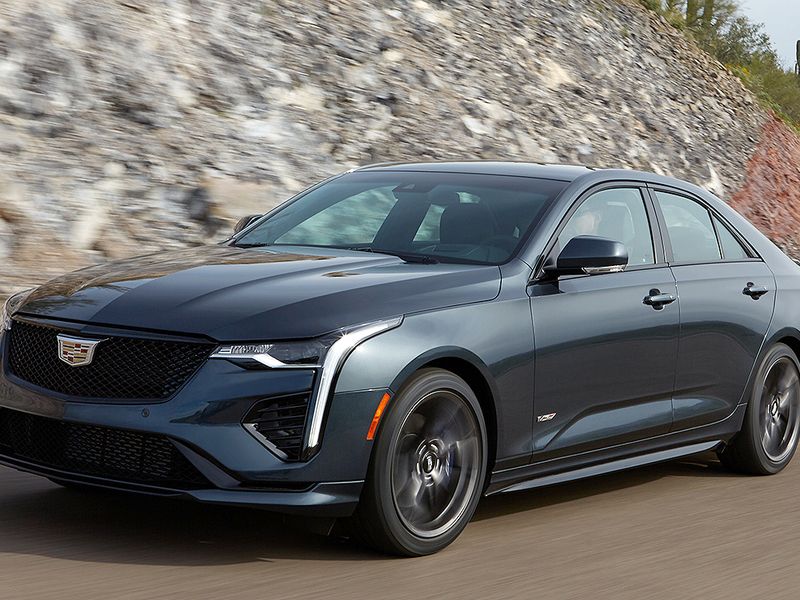
Joining the Cadillac lineup this year is the 2020 Cadillac CT4-V. The subcompact sedan is equipped with a 2.7-liter turbo engine rated at 325 hp and 381 pound-feet of torque. The CT4-V features “a unique three-step sliding camshaft” that helps optimize performance at all speeds, a 10-speed automatic transmission, magnetic ride control and a host of performance parts and equipment. We’ve collected a sampling of early CT4-V reviews from the automotive media.
“We only got to drive the CT4-V this go around, but on the road, we found it strikes a near-perfect balance between luxury and performance. Its eagerness and athleticism never encroach on its luxury mission until you ask them to, whether you dial in your own drive mode profile — Cadillac calls it “My Mode” — or you simply reach for the one-click V-Mode option on the steering wheel.
“When you’re on the highway, the CT4-V is composed and buttoned-down without being in-your-face. Its adaptive cruise control (part of the $1,100 Driver Assist package) maintains speeds just about perfectly, demanding little attention and prompting little consternation. It can also be shut off if you’d prefer plain old cruise control. The seats are relatively plush but supportive and offer plenty of adjustment for individual preferences — a bit of a theme for the CT4-V.”
— Byron Hurd, Autoblog
“The 2.7-liter again betrays its truck-based roots in how it sounds, though. There’s an agrarian harshness to the exhaust note, which is too prominent in the cabin thanks to the same Bose-backed sound manipulation I complained about in the CT5-V. Moreover, aside from some subtle burps while shifting at the tippy top of the rev range, the four-cylinder lacks all the additional acoustic charms of its big brother — don’t drive the CT4-V expecting an enjoyable soundtrack.
“As with the CT5-V, the CT4-V’s standard magnetic ride control system is a gem. The adaptive dampers use the tried and tested trick of zapping magnetorheological fluid to instantly adjust firmness. When you want your Caddy to feel sporty and agile, Sport and Track firm up the dampers to take maximum advantage of the CT4-V’s near-perfect distribution of its 3,600-pound mass. Just trying to survive the freeway commute? Switch to Tour, where the softened dampers conspire with clever tuning, ample sound-deadening and restrained 18-inch wheels and 235/40 summer tires to deliver a plush ride. The ride is quiet, too, with little suspension noise. In terms of outright ride/handling balance, the CT4-V might be the best in class.
“Like the CT5-V, though, the brake-by-wire system is awful. The pedal is incredibly stiff and very, very difficult to modulate. Engineers opted for brake-by-wire for the Brembo stoppers because it allows owners to adjust brake response via the drive modes. That’s fine in theory, but the available settings offer very little variation. I’d undoubtedly adjust to the brake pedal over time, but that doesn’t change the fact that the system feels very poorly tuned. But hey, my tester’s blue brake calipers are cool as hell, at least.”
— Brandon Turkus, Motor1
“building on the ATS’ dynamic excellence, the CT4-V also drives like a thoroughbred. Its steering wheel feels great in your hands and is meatier than the deli counter at your local grocer, with a thick, nicely contoured rim. The smattering of secondary controls mounted on the spokes is logically laid out and easy to use. The CT4-V’s steering itself is nicely weighted and particularly hefty when you put the car in Sport or Track modes. Unlike so many modern vehicles, this Cadillac actually provides a bit of road feel, with some pavement textures being detectable through the wheel.
“In spite of its sporting intentions, the CT4-V’s ride quality is superb, far better than what the ATS-V provided. Yes, it’s firm, but it’s also incredibly well controlled and refined with no grittiness or harshness. Suspension inputs are dealt with almost instantly thanks, in part, to the ZF MVS passive dampers that are standard equipment on all-wheel-drive models. CT4-Vs without this traction-enhancing feature are fitted with GM’s fantastic Magnetic Ride Control system, which alters damper firmness in fractions of a second to cope with varying road conditions. Either way, you can’t go wrong.”
— Craig Cole, Roadshow by CNET
“It hurts less if you think of the CT4-V (and its CT5-V stablemate) as a V-lite. Which is no bad thing, as the CT4-V accomplishes the miraculous feat of making an ATS-V feel oversprung. This car is vastly more compliant and friendly, engaging and playful without making you regret it two hours into the drive. The steering is quick and nicely weighted, and the firm, progressive brake pedal is among the best you’ll find this side of $100,000. GM’s chassis-development team is one of the underappreciated success stories of the last decade, its primary beneficiaries being Cadillacs, the Corvette, the Camaro and — oddly enough — GM’s pickups.”
— Jared Gall, Car and Driver
“Rear-drive CT4-Vs get the latest Magnetic Ride Control 4.0 damping system, which now includes accelerometers mounted to each damper, but the space required for this extra equipment doesn’t package with all-wheel drive, so our test car features new passive variable-damping shocks from ZF. (They save enough money to allow Cadillac to offer AWD for just $500.) We’ve been very impressed with MR 4.0 on the C8 Corvette, and we’re sure it works wonders on the rear-drive CT4, but our car demonstrated remarkable suppleness on the frost heaves and other low-amplitude impacts that mar Michigan’s roads while controlling body motion admirably in the twisties. Body lean is minimal in high-g corners, and the all-wheel traction and high-grip tires enable impressive acceleration out of the corners. And of course, all of the subcompact competitors we’re talking about are based on transverse-engine front-drive architecture, whereas the CT4’s longitudinal rear-drive architecture brings it much closer to the ideal 50/50 front/rear weight distribution. This affords the Cadillac terrific balance that calls to mind a 3 Series or rear-drive 2 Series BMW.”
— Frank Markus, Motor Trend